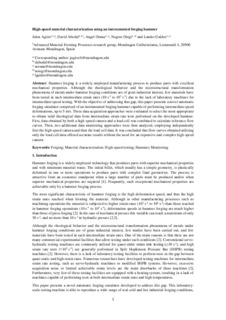Izenburua
High-Speed Material Characterization Using an Instrumented Forging HammerArgitalpen data
2021Bertsioa
PostprintaDokumentu-mota
Kongresu-ekarpenaKongresu-ekarpenaHizkuntza
IngelesaEskubideak
© 2021 The Minerals, Metals & Materials SocietySarbidea
Sarbide irekiaArgitaratzailearen bertsioa
https://doi.org/10.1007/978-3-030-75381-8_100Non argitaratua
Forming the Future. The Minerals, Metals & Materials Series Daehn G., Cao J., Kinsey B., Tekkaya E., Vivek A., Yoshida Y. (eds). Pp. 1201 - 1215. Springer, 2021Argitaratzailea
SpringerGako-hitzak
forging
Material characterization
High-speed testing
Hammer ... [+]
Material characterization
High-speed testing
Hammer ... [+]
forging
Material characterization
High-speed testing
Hammer
Monitoring [-]
Material characterization
High-speed testing
Hammer
Monitoring [-]
Laburpena
Hammer forging is a widely employed manufacturing process to produce parts with excellent mechanical properties. Although the rheological behavior and the microstructural transformation phenomena of m ... [+]
Hammer forging is a widely employed manufacturing process to produce parts with excellent mechanical properties. Although the rheological behavior and the microstructural transformation phenomena of metals under hammer forging conditions are of great industrial interest, few materials have been tested in such intermediate strain rates (10–103 s−1) due to the lack of laboratory machines for intermediate speed testing. With the objective of addressing that gap, this paper presents a novel automatic forging simulator comprising an instrumented forging hammer capable of performing intermediate speed deformations, up to 5 m/s. Three data acquisition approaches were evaluated to select the most appropriate approach and obtain valid rheological data from intermediate strain rate tests performed on the developed hammer. First, the data obtained by both a high-speed camera and a load cell was combined to calculate reference flow curves. Then, two additional data monitoring approaches were then analyzed, employing independently first the high-speed camera and then the load cell data. It was concluded that flow curves obtained utilizing only the load cell data offered accurate results without the need for an expensive and complex high-speed camera. [-]





















